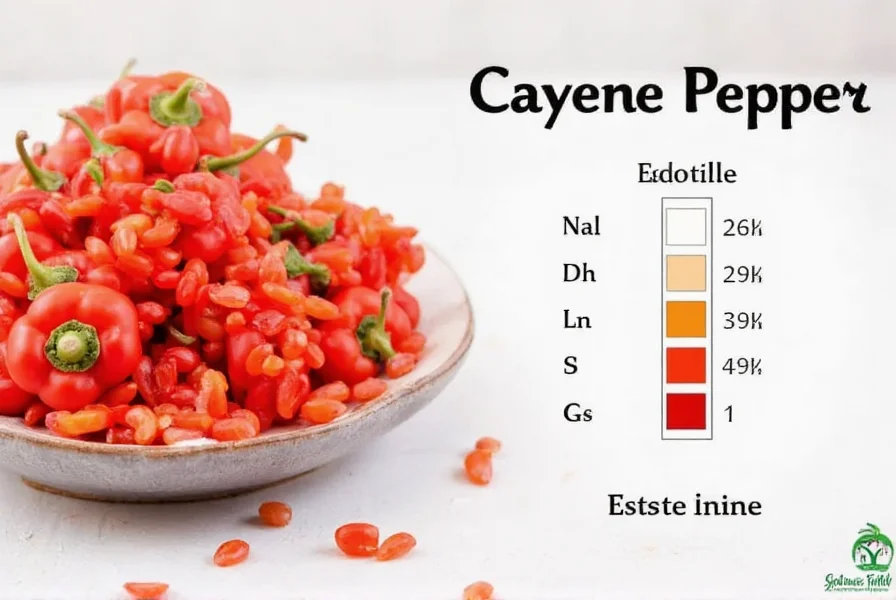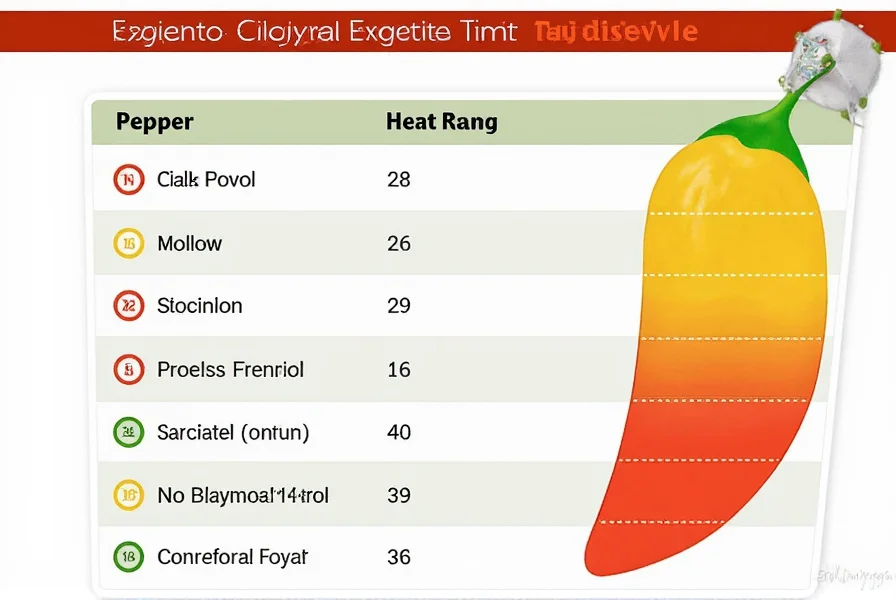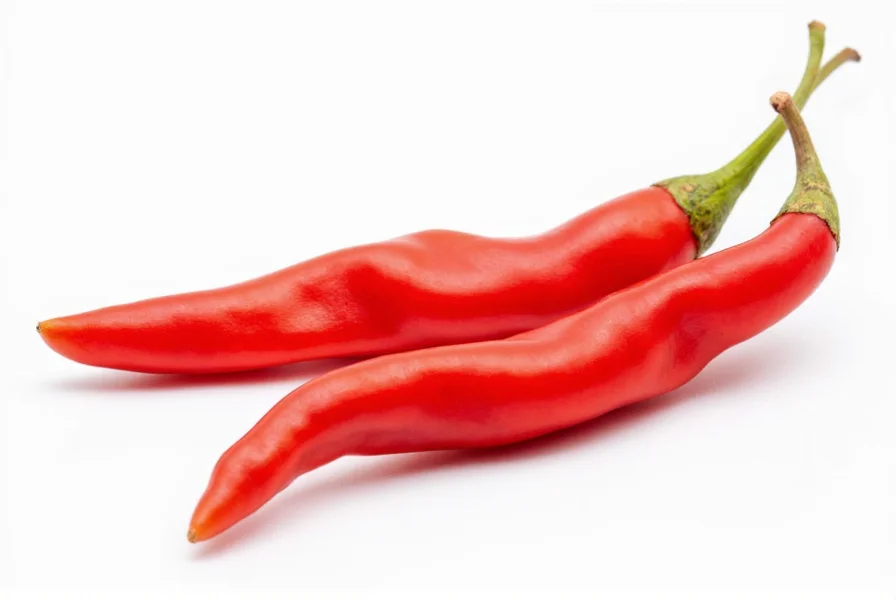Understanding cayenne pepper scoville units provides essential context for culinary applications and personal heat tolerance. The Scoville scale, developed by pharmacist Wilbur Scoville in 1912, measures the concentration of capsaicinoids—the compounds responsible for a pepper's heat. While cayenne consistently falls within the 30,000-50,000 SHU range, several factors influence its actual heat level in practice.
What the Scoville Scale Reveals About Cayenne Pepper
The Scoville Organoleptic Test originally measured heat through human taste panels diluting pepper extracts until heat became undetectable. Modern high-performance liquid chromatography (HPLC) now provides more precise measurements of capsaicin concentration, which are then converted to Scoville units.
Cayenne's position on the scale makes it significantly hotter than jalapeños (2,500-8,000 SHU) but milder than habaneros (100,000-350,000 SHU). This intermediate heat level explains cayenne's popularity in global cuisines—it delivers noticeable warmth without overwhelming other flavors.
| Pepper Variety | Scoville Heat Units | Relative Heat Level |
|---|---|---|
| Cayenne Pepper | 30,000-50,000 SHU | Medium-Hot |
| Jalapeño | 2,500-8,000 SHU | Mild-Medium |
| Habanero | 100,000-350,000 SHU | Very Hot |
| Serrano | 10,000-23,000 SHU | Medium |
| Thai Bird's Eye | 50,000-100,000 SHU | Hot |
Factors Influencing Cayenne Pepper Heat Variability
Several elements affect where specific cayenne peppers fall within the 30,000-50,000 SHU range:
- Growing conditions: Soil composition, climate, and water stress can increase capsaicin production
- Ripeness: Fully mature red cayenne peppers typically measure hotter than younger green varieties
- Plant genetics: Different cultivars exhibit natural variations in heat intensity
- Processing methods: Drying concentrates capsaicin, making powdered cayenne feel hotter than fresh peppers
These variables explain why two cayenne peppers from the same batch might register different heat levels when measured. Food scientists note that capsaicin distribution isn't uniform throughout the pepper—seeds and inner membranes contain the highest concentrations.

Practical Implications for Cooking and Consumption
Understanding cayenne pepper scoville units helps home cooks and professional chefs make informed decisions. At 30,000-50,000 SHU, cayenne delivers noticeable heat that enhances rather than dominates dishes. This makes it ideal for:
- Adding subtle warmth to sauces and marinades without overwhelming other ingredients
- Creating balanced spice blends where heat complements rather than masks flavors
- Providing consistent heat in commercial food production (unlike fresh peppers with variable heat)
- Gradually building tolerance for those exploring spicier cuisines
When substituting cayenne for other peppers, remember that 1 teaspoon of cayenne powder equals approximately 8-10 fresh jalapeños in heat intensity. Always start with less than you think you need—you can add more heat, but you can't remove it once incorporated.
Measuring Heat: From Subjective Testing to Scientific Precision
The original Scoville test relied on human tasters diluting pepper extract in sugar water until heat became undetectable. A rating of 30,000-50,000 SHU meant the extract required 30,000-50,000 times dilution before heat disappeared. This subjective method had significant limitations:
- Taster fatigue affected consistency across multiple tests
- Individual heat tolerance varied widely between testers
- Results weren't precisely replicable
Modern HPLC testing measures actual capsaicinoid concentration in parts per million, then multiplies by 15 to convert to Scoville units. This scientific approach provides consistent, objective measurements for cayenne pepper scoville units and other chili varieties.

Common Misconceptions About Cayenne Heat Levels
Several myths persist about cayenne pepper scoville units:
- Myth: All cayenne peppers have identical heat levels
Reality: Natural variation means individual peppers can differ significantly within the established range - Myth: Redder cayenne peppers are always hotter
Reality: Color indicates ripeness but not necessarily heat—growing conditions play a larger role - Myth: Removing seeds eliminates all heat
Reality: While seeds contain concentrated capsaicin, the surrounding placental tissue holds most heat compounds
Understanding these nuances helps consumers make better choices when selecting cayenne products for specific culinary applications.
FAQ Section
What is the exact Scoville rating for cayenne pepper?
Cayenne pepper typically measures between 30,000 and 50,000 Scoville Heat Units (SHU). This range represents the standard measurement for most commercially available cayenne varieties, though specific heat levels can vary based on growing conditions and pepper maturity.
How does cayenne compare to other common peppers on the Scoville scale?
Cayenne (30,000-50,000 SHU) is significantly hotter than jalapeños (2,500-8,000 SHU) and serranos (10,000-23,000 SHU), but milder than habaneros (100,000-350,000 SHU) and ghost peppers (855,000-1,041,427 SHU). It falls in the medium-to-hot range, making it versatile for adding noticeable heat without overwhelming other flavors.
Why does cayenne pepper heat level vary?
Cayenne pepper heat varies due to growing conditions (soil, climate, water stress), ripeness (red peppers are typically hotter than green), genetic differences between cultivars, and processing methods. Even within the same plant, individual peppers can show significant variation in capsaicin concentration.
Is cayenne pepper powder hotter than fresh cayenne?
Yes, cayenne powder typically feels hotter than fresh cayenne peppers because the drying process concentrates capsaicin. One teaspoon of cayenne powder generally equals the heat of 8-10 fresh jalapeños. However, the actual Scoville measurement remains consistent—the concentration just makes the heat more immediately noticeable.
How can I safely handle cayenne pepper without discomfort?
Wear gloves when handling cayenne peppers, especially when cutting or seeding them. Avoid touching your face, particularly eyes and nose. If you experience burning, apply dairy products like milk or yogurt rather than water, as capsaicin is fat-soluble. Always wash hands thoroughly with soap after handling, and consider using kitchen tools rather than fingers to minimize direct contact.











 浙公网安备
33010002000092号
浙公网安备
33010002000092号 浙B2-20120091-4
浙B2-20120091-4